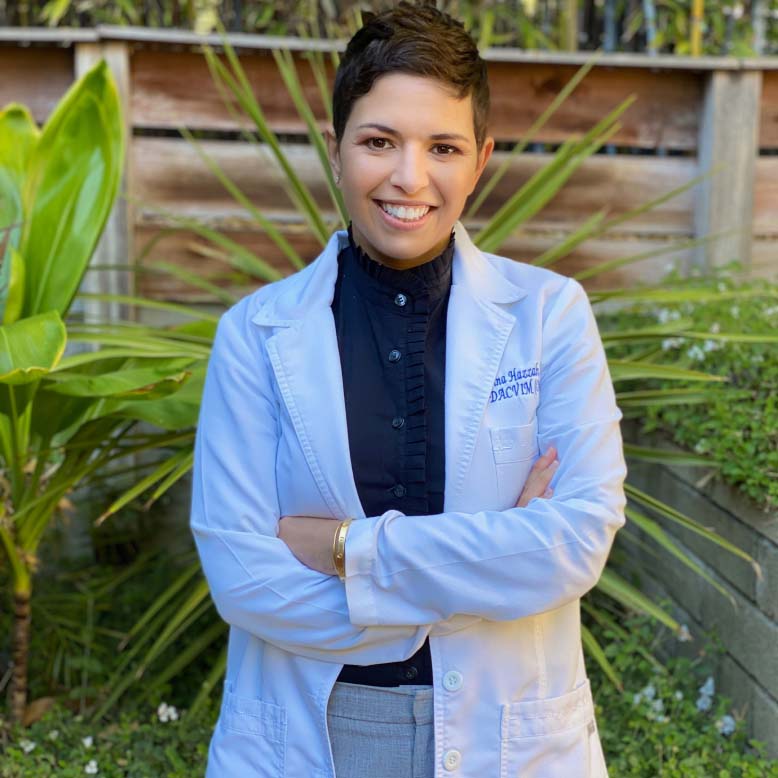Join the discussion below

Nathan Crane is an award-winning author, inspirational speaker, plant-based athlete, event producer and 18x award-winning documentary filmmaker. Nathan is the Founder of The Panacea Community, Creator of the Global Cancer Symposium, and Director and Producer of the documentary film, Cancer; The Integrative Perspective. He is also the Director of Strategic... Read More

Trina Hazzah was born and raised in Washington DC. She attended Tuskegee University School of Veterinary Medicine where she earned her Doctor of Veterinary Medicine in 2006. She completed her small animal internship at Red Bank Veterinary Hospital in New Jersey and a 3-year residency in medical oncology at the... Read More
Reducing the side effects and morbidities in pets through integrative veterinarian medicine.
Pet case studies using integrative medicine for healing cancer.
The truth about cannabis and cancer in our furry loved ones.
Nutritional chinese herbal support for helping our pets heal.
How to dose and give your pets healing herbs easily.
The importance of CBD and THC in Cannabis treatment and why THC is not scary.
The natural healing diet for dogs and cats to help your beloved furry friends heal.
Related Topics
Acupuncture, Anti-cancer Herbs, Appetite Stimulants, Blood Flow, Cancer, Cannabis, Cats, CBD, Chemo, Chinese Herbal Medicine, Chinese Herbs For Pets, Conventional Vet, General Health, Healing, Hyperbaric Oxygen, Immune System, Integrative Vet, Kidney Disease, Longevity, Medicinal Mushrooms, Mushroom Supplement, Natural Therapeutics, Pets, Phlegm, Prolonging Life, Qi Deficiency, Quality Of Life, Quantity Of Life, Radiation, Reducing Pain And Suffering, Spleen Qi Deficiency, Stagnation, Stasis, Traditional Anti-nauseas, Traditional Modalities, Transporters, Western Herbs, Yin DeficiencyNathan Crane
Hey, it’s Nathan Crane, Director of the Health and Healing Club and host of the Conquering Cancer Summit. And today I am honored and excited to welcome you to a very special interview. Trina Hazzah earned her doctorate of veterinary medicine in 2006. She completed her small animal internship at Red Bank Veterinary Hospital in New Jersey and a three year residency in medical oncology at the Veterinary Oncology and Hematology Center in Connecticut. She’s also completed the requirements to be a certified veterinary Chinese herbalist, which I think is pretty awesome, a great skillset to have in your tool bag, if you will. And Dr. Hazzah developed an interest in cannabis medicine during her quest for finding effective integrative approaches for veterinary cancer patients.
She’s given numerous lectures to veterinarians, educating them on the topic of cannabis medicine for animals. Dr. Hazzah is a co-founder and the president of the Veterinary Cannabis Society, and a member of the Society of Cannabis Clinicians, the Canadian Association of Veterinary Cannabinoid Medicine, the Veterinary Cancer Society, the American College of Veterinary Internal Medicine, the American Holistic Veterinary Medical Association and the California Veterinary Medical Association. So, you can trust what she tells us today. Her website is Dr., that’s D-R, trinahazzah.com. Dr. Hazzah thank you so much for joining us.
Trina Hazzah DVM, DACVIM, CVCH
Thank you for having me. It’s really my pleasure.
Nathan Crane
Yeah, So what was it, if you could share with us a little bit, your backstory, what was it that kind of prompted you to transition from being a, what we might call conventional veterinarian to an integrative vet?
Trina Hazzah DVM, DACVIM, CVCH
That’s a great question. I think that during my residency while I was training, I always started looking into other modalities. I would ask my mentor, “Well, how about hyperbaric oxygen “for our radiation patients “that aren’t having appropriate healing?” Or, “How about this mushroom supplement “to use along with chemo?” And he would say, “Look, you’re focusing on medical oncology. “This is what your residency is. “Focus on this and then you can look into it down the road.” And so, I appreciated that because I got to learn all the details of cancer biology and all the things I needed to become a board certified oncologist. But I always kind of had that push behind me to do more. And I felt that the conventional oncology wasn’t enough. So I moved from Connecticut to Los Angeles, California.
Thank goodness for that, not just for the weather, but also because the clientele here were also very much interested in having some other additional alternative type approaches or integrative approaches. And so that was really kind of my jam, right? I really was interested in it. And so were the clients. And that really pushed me to say, after probably practicing for, I would say four or five years of mostly conventional and drizzling a little of the, some of the integrative approaches, it wasn’t enough. I felt like, God, was there more I could do? Could I prolong resistant mechanisms, meaning could I keep cancer patients on chemo longer and making it work longer? Could I reduce some of those morbidities that they were getting or side effects they were getting with chemo and radiation and some of these other traditional modalities, by incorporating some other type of therapies like cannabis and Chinese herbal medicine and Western herbs and medicinal mushrooms and other modalities? And so the answer was, well I first needed to get educated.
I’m a big nerd where I felt like I had to learn everything about every subject before I really started practicing it. Right, so after finishing the residency and medical oncology after a few years, I was like, “Hmm, I think I should learn everything I can “about Chinese herbal medicine “before I start implementing it.” So I went to the Chi Institute and got certified in Chinese herbal medicine, and literally just started using it in all my cases, the folks that were interested in implementing it. And I saw such tremendous differences in quality of life and in some cases, quantity as well. And so much more
Nathan Crane
Well Trina, if can share a little bit about some of those case studies that really stand out to you.
Trina Hazzah DVM, DACVIM, CVCH
I can tell you you always remember the first, right? You always remember the first. So this was a case that it was a dog, a Shetland Sheepdog that had transitional cell carcinoma of the bladder. So that’s the most common bladder cancer that dogs get. And this dog was really starting to have side effects of the chemo. And one of the side effects this poor pet was having, secondary to the progression of its cancer as well as one of the therapeutics, a nonsteroidal, is it started develop some kidney disease, and it stopped eating. She wouldn’t eat. She wouldn’t wanna do… She really wasn’t even walking over to her food anymore. The owner was really struggling to get any food into this poor dog. And so she called me and said, “Listen, I think it’s time.” And I said, “Would you let me at least just try” We’ve tried all of the traditional anti-nauseas and appetite stimulants and nothing was working. “So will you just come back “and let me try one of the Chinese herbs. “I learned all about this, I really wanna see. “I’m hopeful this will work.” And so I said, “Give me three days. “If after three days of trying this herb, “there’s no improvement, “then I of course support your decision.” So she brought her in and I did it evaluation. And based off of my Chinese herbal exam I confirmed that she had what they call a yin deficiency. And so I was able to supplement her yin with this particular Chinese herbs that would help support her kidneys.
And I also put her on something to help with what they call a spleen qi deficiency. What was actually playing a role in preventing her from eating? So I said, “Just try these two herbs, let’s just see.” Two and a half days. I mean, we were almost at that third day. Two and a half days later I get a phone call that says, “You’re not gonna believe this Dr. Hazzah, she’s eating. “She’s eating, she’s going for walks again.” And I had stopped everything else. It was just those two herbs. And she was happy, she was playing. I mean, it was just like this transformation from a dog that she thought she was gonna have to put down, to a dog that was again eating and playing and just enjoying life again. And I kind of, and I almost didn’t believe it. I said, “So wait, there’s really something to this.” And, God, she must’ve gone on for about three months until it was her time. And three months to someone that just adores and loves their pets like a family member is so much time, especially when it was quality time. And I’ve had many more of those cases for the additional five, six years of my practicing Chinese herbs, along with conventional therapy. And it just feels so good inside that I wasn’t in a place to say, “You know what, “I have nothing else to offer.” I had something else to offer. I continue to have something to offer. And that just felt really good to all of us that were around watching that case. And the many other cases that occurred.
Nathan Crane
Yeah, I can appreciate the level of gratitude and grace that I’m sure you experienced with that case and many others especially now knowing that you have some natural therapeutics that you can implement when maybe all else has failed or is not working, right. And you know that you’re not only potentially prolonging life and quality of life, but also reducing the pain and suffering, because these often have little or no side effects whatsoever and can increase quality of life and decrease pain and suffering, right. So, I mean, I know the power of the Chinese herbs and for humans, but it’s always interesting to hear someone like yourself speak about it for our pets as well.
Trina Hazzah DVM, DACVIM, CVCH
Yeah, yeah, Same with cats, right? Like cats they can be so picky. When there’s such a deficiency and you give them the right herbs they actually almost want it. They come for it. Once they start feeling more balanced, you realize we all know inside of our bodies when we feel balanced, right. We know it, animals know it. And it’s interesting to watch how their behavior change swhen they start to feel more balanced.
Nathan Crane
Is there some herbs in general, that for general health and longevity you have found to be effective for dogs and for cats? Is it same or different herbs? Are there are a couple you can share with us?
Trina Hazzah DVM, DACVIM, CVCH
Yeah, so I’m a big, big believer in trying to support a pet’s immune system without a doubt. And there’s a combination of Western herbs and Chinese herbs. One of the ones I use because I was trained at the Chi Institute is what they call Wei Qi booster. And why I love that one is so many, I would say almost all of my cancer patients are deficient in qi. And that could very well be one of the reasons behind the formation of cancer, is that their immune system just isn’t at high alert anymore, right? And so mutations occur and the immune system can’t catch them before it turns into cancer. And so a lot of times these patients are older, they’re more fatigued, they don’t have the energy. And the flow of energy is also stagnant. So there’s kind of a two-prong approach that I use a lot with my cancer patients. One is supporting the immune system heavily with Chinese herbs, Western herbs, medicinal mushrooms. And one of the herbs is Wei Qi booster to support the immune system and support qi, ’cause again, they’re oftentimes deficient in qi.
And then the second is really to try to open up flow and break down stagnation stasis. Because that also is potentially the, is kind of the background behind why cancer can form into this, what we say starts off as phlegm and turns into stagnation in stasis. And so finding a way to open up blood and qi and allowing that to flow significantly better is a big part. And then I think some of the art of it too is figuring out what transporters used to use, right? Depending on where the cancer is located perhaps we can push some of those anti-cancer herbs toward a certain area in the body and really opening up channels there. Incorporating acupuncture is huge in this as well. And in improving quality and quantity I think as well. Quality for sure. We have pets that just get so sick from chemo and herbs and cannabis, it doesn’t work enough and sometimes incorporating acupuncture can make all the difference. So it’s really a combination of a variety of different modalities, I think, that support the pet just like you would for a person.
Nathan Crane
Yeah, do you have some, I mean, it’s fascinating to think about giving our pets the same kinds of herbs, these are the same kinds of herbs that we would take as humans, right?
Trina Hazzah DVM, DACVIM, CVCH
Absolutely. Yeah, yeah. We oftentimes, I order from Evergreen, right. Just the same herbs that you probably use and I’ve used before, we just dose them differently. You don’t give six capsules. Maybe they just get three for a big dog twice a day or four, it depends on the size. So it’s certainly… I think the biggest challenge in pets is how do you get the herbs into them, right? So with us, we just say like, “Okay, it’s gonna taste like crap but I’m gonna take it.” And you feel the difference, right? I mean, we’ve all, I’ve certainly been on tons. And Gary and I have this conversation on a regular basis over how many supplements we’re both taking. And so we are true believers in it and we practice what we preach. But it’s easier to convince ourselves it’s the right thing and we just do it, make it with something tasty and we move on.
For a dog and even more so for a cat, how do you do it? And I think it’s the art of how do you trick your animal when sometimes they are that smarter than we are sometimes, right? And so how do you, and getting it and really tasty, tasty food and tuna fish and baby food and peanut butter. And the joke at the hospital, at my department is you always know which patients or doctor has patients, because they’re almost all a little bit overweight. And that’s because the ones that are on tons of Chinese herbs and supplements are getting them with peanut butter balls and cookies and this and that. So they’re all just getting more. It’s really not the worst thing, they’re cancer patients. And so, right, you’d rather than be a little overweight than underweight.
Nathan Crane
Absolutely. So do you have any case studies that you can share, even any anecdotal studies where you’ve worked with a dog or a cat and they had some form of cancer and through an integrative approach you were actually able to completely stop the proliferation or the growth of that cancer or reverse it completely?
Trina Hazzah DVM, DACVIM, CVCH
Yeah, yeah, no, I absolutely do. Let me see which one. God, right, there’s so many, let’s see. I’m trying to think of one that I oftentimes… Well, can I give you two, ’cause I can’t… There’s two good ones that I
Nathan Crane
Yeah, absolutely.
Trina Hazzah DVM, DACVIM, CVCH
So one of them was a Jack Russell Terrier that came to me with three different types of cancer. An oral tumor, back of its jaw. Is called squamous cell carcinoma, a bladder tumor called transitional cell carcinoma, that we already just talked about. And then an indolent or less aggressive lymphoma, so blood cancer, right, lymph node cancer. And so the owner came to me and said, “Look, we wanna do what we can, but he’s an older guy. “We don’t wanna go crazy. “What if we just did some surgery “to remove this tumor in the mouth “and remove the bladder tumor “and then we can start “on what they call a targeted therapy.” Something that targets the mutations that are telling the cancer to grow up, in the growth factors. So we said, let’s do that and let’s add in… Let’s start with that and see how it goes. So we did that and about six months later the tumor came back in the mouth with a vengeance and as well in the bladder a little bit but the mouth was horrific, where the dog could not even see.
The tumor crawled all the way up it’s mandible toward the back of its eye. And he was unable to see from that one eye and he could hardly open and close his mouth. So they came to me and said, “Look, things are worse. “I think we don’t wanna do radiation. “We don’t wanna do chemo still. “We just wanna focus on quality. “Is there anything you can offer?” And I said, “Why don’t we try cannabis?” “There’s some published information on carcinomas “responding to cannabinoid therapy. “Here is a ratio I would consider based off of the research. “And I do not think he’s gonna get sick “if we started at appropriate dosing “and we use a formulation that’s safe without contamination, “and pesticides and things like that.” So we moved forward with cannabis and the owners wanted to continue with the targeted therapy. They said, “Let’s just do both.” So we can combine both and within probably
Nathan Crane
Sorry, before you share that, which I really wanna hear. What was the targeted therapy you were doing at the time?
Trina Hazzah DVM, DACVIM, CVCH
It’s called Palladia, Toceranib is the generic name and Palladia is the trade name. It’s the only FDA approved targeted therapy for pets. And it’s been out for, I would say, 15 years or so at this point.
Nathan Crane
Palladia, so is it a chemical compound, is it a drug, is it a nutritional therapeutic?
Trina Hazzah DVM, DACVIM, CVCH
It’s a drug, it’s a pharmaceutical, it’s a pharmaceutical.
Nathan Crane
So you were doing that after the surgery and nothing else, no herbs, anything else?
Trina Hazzah DVM, DACVIM, CVCH
Nothing else.
Nathan Crane
And then it came back with a vengeance, the tumor came back. So now you’re still doing that drug but now you’re doing cannabis?
Trina Hazzah DVM, DACVIM, CVCH
Yep. And I think they wanted a hold on herbs or something like that initially, and said, “Let’s just do one thing.” I think that the dog maybe was picky or whatever it was. There’s always a reason behind why someone chooses what they choose. So we started the cannabis at that ratio. It was a one-to-one ratio of THC to CBD, and a very small dose. This is the most interesting part of the whole thing, for me as a scientist. Is it was one milligram of THC and one milligram of CBD. That’s it.
Nathan Crane
Per day?
Trina Hazzah DVM, DACVIM, CVCH
Twice a day.
Nathan Crane
Twice a day.
Trina Hazzah DVM, DACVIM, CVCH
Twice a day, but that was the dose, right?
Nathan Crane
One milligram, yeah,
Trina Hazzah DVM, DACVIM, CVCH
That’s it.
Nathan Crane
That’s a tiny amount.
Trina Hazzah DVM, DACVIM, CVCH
That’s it, tiny amount. But within about a month, the tumor was significantly smaller.
Nathan Crane
Whoa!
Trina Hazzah DVM, DACVIM, CVCH
Right, and they didn’t start anything else. Finally, I said, you got to come in and have me look. They came in. I could barely find the tumor in the dog’s mouth. The only thing I did was that a one milligram of each compound and onto the Palladia. So then I looked back as a scientist. I think God, there’s gotta be synergy. So then, of course, I went down this path of synergy and went crazy for every single tumor, combining all these. And honestly I didn’t see it work as well for any other tumor. And I couldn’t even replicate it for the same tumor in a cat. It was just this particular tumor, this particular tumor genetics that seemed to work so well with this combination therapy. I mean it responded beautifully. So then to hear this is the crazy part of it. So then probably the dog was on it for several months and the owner forgot to reorder. Two weeks pass, the tumor comes back. I doubled the dose, I couldn’t stop it. And he got some radiation to keep him comfortable and then he passed away.
Nathan Crane
Wow, what a story.
Trina Hazzah DVM, DACVIM, CVCH
Right, so interesting. What a story, yeah, and quality. I mean, you should see the pictures. One picture of him barely able to open his eye and his mouth to the next picture, the owner was sending me these pictures. He’s at the beach with a ball in his mouth. He both eyes look totally normal. He’s running up and down the beach. I mean, that’s why we do what we do in veterinary medicine. To see that like that happy, happy. And his name was Hammer, and we’d always have a hammer
Nathan Crane
Nice.
Trina Hazzah DVM, DACVIM, CVCH
And so he was a special guy. So that was one case. The other case is a dog that’s still doing very well, knock on wood. He came to me with metastatic salivary gland carcinoma. Meaning that he had a tumor in the back of his throat, a salivary gland that was affected by a carcinoma, an adenocarcinoma. And it actually spread to a local lymph node. And possibly there was a nodule in the lung. And he was, had blood coming from his nose. I mean, he was a really sick, sick guy. And the internal medicine doctor sent me the case and said, “Listen, I’m not sure how much time he has, “but can you help him?” So I said, “Yeah, I mean, I’m here to offer all the options. “Let’s see what we can find that works. “And most important is let’s get him comfortable.” So this is a case where I implemented Palladia again, right. That was a great one for certain carcinomas. These are owners that weren’t wanting to do high doses of chemotherapy. And to be honest with you, I don’t believe that chemotherapy would have worked any better. That’s what I’m gonna say that again. I do not believe chemotherapy would have worked any better in many of these cases. So I never looked back and think I should have done anything differently. ‘Cause I’ve done the chemo for so many years before and didn’t see the results I was seeing with this.
Nathan Crane
Right.
Trina Hazzah DVM, DACVIM, CVCH
And the benefit is they got to take this pill, this targeted therapy at home with a peanut butter treat. They’re not coming in and getting a catheter placed. So quality of life was already better with the way we were implementing that therapy. We started about three or four different Chinese herbs, medicinal mushrooms. We added in curcumin to help with inflammation. And then of course we added in cannabis. I say, of course, because that’s certainly a very a big area of interest for me. And so we added in cannabis. Again, I was hoping for this synergistic approach with all of these molecules. Perhaps additive with some and other synergistic. And so within about a month or so the bleeding from the nose stopped completely. The owner said, “My God, he’s not sneezing anymore. “He’s starting to breathe even better.” The lymph node in the neck started to go down.
And we’re now, my God we have to be close to three years out. And I saw him about a month or so ago and he looked wonderful. His lymph node was totally normal. He does not have any, there’s no lung tumors at all in his chest. There’s no obvious recurrence of his disease. Currently he’s on a very low dose of Palladia. We had tapered down, we didn’t taper her off of it. We tapered down on the minimal amount of Palladia, and he’s on all the Chinese herbs and on cannabis at fairly high levels of THC. He’s actually on a THC dominant product where he’s on more THC than CBD, which you rarely hear out there. But there is something in that combination that has kept him going and feeling so good for as long as he has.
Nathan Crane
Well, and three years, it sounds like, I mean it could be a lot in a human’s life depending on where they’re at in their life, but does it sound like a lot? In a dog’s life that’s a lot of years, right? That’s depending on the age, I don’t know what another 10, 12, 15 years maybe added to the life, yeah.
Trina Hazzah DVM, DACVIM, CVCH
Yeah, exactly.
Nathan Crane
Yeah, that’s amazing.
Yeah, so how important, so talking about cannabis, how important is that one-to-one ratio in terms of a therapeutic dose of cannabis THC and CBD blend versus just CBD or just THC?
Trina Hazzah DVM, DACVIM, CVCH
Great question. I think it has to do with the type of cancer and if you. I’m hesitant because I truly believe that once we understand the genetics of the cancer and the ability for it to express certain receptors, cannabinoid receptors and orphan receptors and secondary receptors that cannabis, the compounds within the cannabis plant work on, you’d have a very good idea of if this tumor is gonna respond to THC or is it gonna respond to CBD. The generic, oh, it’s a one-to-one, which is by the way where we were years, just a few years ago. Where cancer should be on a one-to-one. I don’t necessarily agree with that. Look at the second case I told you, is on a 30:1 THC to CBD, and I wouldn’t ever reverse it for that dog, ’cause he’s still here with a metastatic tumor. The first case was a one-to-one and that was the magical combination for that one.
There are other dogs that are on a CBD dominant product, 20:1, 12:1, whatever it may be and still doing excellent, responding well, and it’s the CBD molecule probably doing more of the heavy lifting. And there’s so many other compounds. I mean, CBG is a really important compound because that one is kind of the new fad for so many reasons. But from a cancer standpoint, I think CBG is gonna do a lot of the heavy lifting for us. A CBG-CBD blend with a little THC might be magical specifically for certain tumors that have what they call a TRPM8 overexpression, because it’s a pretty strong or potent antagonist, the TRPM8. TRPM8 is overexpressed in prostate, is one of the big ones, breast cancers, other carcinomas as well. But prostate’s a really big one. So if I were to put together formulations for certain tumors, I would go off of what we know as their typical kind of receptor expression.
But I think it’s gonna be based on so much more than that. That specific tumor on that specific person. Not all tumors, not all carcinomas, not all prostate carcinomas in dogs or people are gonna express the exact same levels of receptors. Or maybe inherently in that person, their endocannabinoid system is grossly different. Yours, Nathan, is gonna be different than my system. And that might mean I might need a lot more THC than yours ’cause you have a lot of endocannabinoids floating around. And that’s the same thing for our patients. I think, with multiple comorbidities, these dogs that have lots of issues, you may need to really work a little harder to really balance their system than a dog that may not have other issues. So it’s not gonna be as easy as use this compound for this or this ratio for that. But I think as more research goes on we’re gonna get a better handle on that. I really do
Nathan Crane
Is the research showing for animals, cats and dogs specifically, that it’s completely safe, CBD and THC combined at pretty much any of the levels that you spoke about already?
Trina Hazzah DVM, DACVIM, CVCH
There are very few studies on high amounts of THC, right? There’s only one study out of Canada that showed that dogs actually, they tolerated the high amounts of CBD way better than the high amounts of THC. I mean, that’s pretty well known, right? I mean, it would be any human being that would also be in that situation. The other kind of issue with that study. And I think a lot of times you have to really look into the study design itself, is the way the study did it, is they would give a dose and they wait three days later and then give a higher dose and then give three days later. And so you’re not building up true tolerance. Where in a dog, right, or when I’m treating a patient, they’re very gradually going up and we titrate the dose. So for instance, this last dog that I mentioned that’s on very high amounts of THC.
That dog is probably close to 40 milligrams of THC twice a day, which is significant. If you or I took that we would be sleeping, and this dog is running around like a puppy because it’s taken to year and a half, two years to really get up to that dose, and it’s been a gradual increase. So I think in my experience, THC is extremely well tolerated when dosed appropriately and titrated appropriately. It’s not perfect for every single pet. Some pets can’t go over a certain amount regardless of titration. They have a little bit of urinary incontinence or whatever it may be. So you just listen to their bodies, just like we would listen to our own bodies and adjust the dose accordingly. Others need a lot more to balance their system. So based off of the animal research, I would say we have a lot of information out there showing that CBD is super safe.
It has been shown to be safe at extremely high doses. THC back in the eighties was published at 3000 milligrams per kilogram, and there was no lethal dose even at that dose. So I believe, yes, it’s safe, but for morbidity’s sake we don’t want our pet staring off at walls for hours and not wanting to go for walks and sleeping. We wanna make sure that they’re happy. I’m not worried about a pet passing away. If they are significantly overdosed on THC they have the potential to aspirate and get pneumonia ’cause they can’t swallow properly.
And in cases like that, if your pet is ever in that situation, by mistake, you gave too much, you gave a human product that was way too concentrated, bring your dog in or your cat into a veterinary hospital and have them evaluated and kept overnight and supported appropriately. But most of the cases of THC overdose, most of them resolve within, sometimes 12 hours, sometimes a day and a half or so. My own cat ended up getting too much and he just stared off for a little bit, for six hours, and by the seventh hour he was up and walking and totally fine. So it was just supporting them through it I think is important and realizing they just need a little bit of support and care, but many of them don’t need to be rushed to the hospital only in very severe cases.
Nathan Crane
Yeah, yeah. It reminds me, I cycle on and off CBD and it’s really high CBD and very, very low to almost no THC and mostly for anti inflammatory and sleep and things like that. And in my own self, when I cycle on it I might take it for a month, a couple months at a time. And my tolerance is, I mean, when I haven’t taken it, for when I take a few weeks off and then I take a dose of it, I mean, I notice it right away. Like I’m just out cold for like eight hours straight. And, I’ll notice it significantly for next few weeks as I’m cycling on it, but then the tolerance starts to build. And then, so after a couple months I’ll cycle off it for a couple of weeks at a time. And as your body obviously adapts to the dosage, you’re gonna respond differently. Right, so.
Trina Hazzah DVM, DACVIM, CVCH
Absolutely.
Nathan Crane
And all the research I’ve seen as well, at least for humans, I mean, you can take massive amounts of CBD and THC without any major complications. Of course you don’t wanna overdo it, overdose it. There’s no point in that, you’re not gonna get any real benefit from that. But in terms of diet and nutritional supplementation, Chinese herbs and cannabis, CBD, THC, how important is it that pet owners not only supplement with what you’re talking about, but also really take a look at the diet and what are some of the foundational principles of the diets for dogs and cats that you teach, that you work with?
Trina Hazzah DVM, DACVIM, CVCH
You definitely hit it on the head. I always say, like you spent all this time and money and sacrifice. You’re doing all these amazing herbs and supplements but then you’re feeding McDonald’s. Like a McDonald here and there isn’t gonna kill ya. But the daily Beneful and all of that stuff. I hope Beneful’s not listening, but I just, I worry very much about that. The carcinogens in those dry foods over time what they do to the body. And you’re working so hard to create this antioxidant effect and then you’re putting in procarcinogens. And so I very, very much worry about it. So for a lot of my patients, I guess I would say it depends on what they’re coming to me for. So there are some patients that I’ll see that are really toward the end, and they’re looking for more palliative care, right. And meaning they were looking for more comfort care.
And this is a patient that really isn’t eating well already. And we’re looking to reduce inflammation, keep them comfortable until the end. And we may only have weeks, months left. In those cases I have them eat whatever they’ll eat. It doesn’t matter to me. I say, if your cat will eat Fancy Feast but that will help you get the herbs and things in, let’s do it. If your pet will only eat hot dogs then that’s what we’re gonna do for now, just try to get organic, no-nitrate hot dogs. But sometimes it is what it is. And they’ll just getting food into them because it’s more important they’re eating. For the cases that are coming to me for what they call more definitive intent. And I use that term meaning there’s a chance that we can get years out, right? We’re gonna get very many months or years out.
We’re looking for more of a longevity, then absolutely the conversation of food who comes up. And usually it comes up first, before I even sometimes implement any of these other modalities, we talk about how do we get your dog or cat off of the food that they’re currently on, get them on a higher quality food that doesn’t have a bunch of fillers, the first ingredient isn’t corn, or rice. We’re looking for a whole food diet, something that is… Oftentimes in my cases if they’re on chemo or some sort of therapy that’s suppressing the immune system I don’t necessarily want them on a raw food, just for the sake of their immune system is already suppressed. So we’ll oftentimes use gently cooked foods or foods that have been cooked in a human grade kitchen that they can pick up or make themselves a homemade diet. And we actually choose the protein based off of their element, their Chinese herbal element.
So if you have, in a lot of the cases I see they run very, very hot too. They oftentimes will have that yin deficiency. And so putting them on chicken is the worst thing, ’cause chicken is actually really heat producing. And so when we start to switch over the food to things like turkey or a white fish, that’s a lot more cooling for their system, owners will say, “God, I noticed there they’re not panting as much. “They seem to be more comfortable. “They’re not just always laid “across a freezing cold marble floor. “They’re now comfy on their beds.” And we’ve taken a lot of those white enriched kind of grains out that produce heat, like white rice or potatoes and things like that.
And put in things like quinoa or sweet potatoes and other things that really support the immune system, but also support the patient’s heat and cold status as well. And then of course we talk about vegetables, and which vegetables, what would be the best things, like cruciferous vegetables, ones that are full of flavonoids and have really profound anti-inflammatory, antioxidant properties. And we go through fish oils, Omega 3s and how important that is and how it can help the cannabinoids actually work even better and help with inflammation. So we really go through this full, I would say, I don’t know, a percentage, maybe 20, 25% of my consults sometimes it’s on food. Yeah.
Nathan Crane
Yeah, it’s that important, right? I mean, that’s why we call these other things supplements, ’cause they should be supplementing our core diet, both in humans and in our pets, ’cause that’s where we’re getting majority of our nutrition, or lack of nutrition is from the food, right. So as we kind of wrap up here, I have a kind of interesting question I wanna ask you. In all of your time training and learning and researching specifically around cannabis, what is maybe one of the most shocking things you’ve learned about cannabis for our pets that you didn’t originally know? What was something that just kind of like blew your mind that maybe of our pet owners should know about cannabis?
Trina Hazzah DVM, DACVIM, CVCH
I think, honestly I think the biggest thing that I would tell pet owners is that THC isn’t scary. I mean, that is the biggest thing that I find that I’m educating on a regular basis, pet owners and veterinarians, I’m talking about. A lot of times I’ll speak with pet owners that will say, “I only want the good one.” And I say, “Which one’s the good one?” “I think it’s the CBD.” And I’ll say, “Actually, they could all be really good “but it’s just how you give it.” And so I think the biggest thing I would say from an education standpoint is THC is not bad. If anything, for our cancer patients, THC over CBD can increase appetite, can reduce pain to a level that CBD can’t even touch. It doesn’t mean that I think they should all be on THC. Absolutely not. I think CBD has a very, very, very big home in pet care. Tremendous.
I think a little bit of THC for certain cases and a lot more in other cases could make such a big difference. When you use a product that’s a CBD-only product, what we call an isolate, you might only get to here. When you add in just a little bit of THC you get to here, and it doesn’t necessarily cause toxicity, when again dosed appropriately. There are very few cases that I’d ever say, be careful when using THC. and the number one case I would say to be worried is a dog or a cat with severe, severe heart disease. Those are the ones I would just be careful because THC has the potential to at reasonable doses to cause an increased heart rate and may even cause an arrhythmia, so we want to just be careful. But the ones that have mild heart disease, I’m not worried about it all. We’ve used them for hundreds of cases and have, knock on wood, have all done fine. And the research certainly hasn’t supported that causing any issues thus far.
Nathan Crane
What are those dose ranges?
Trina Hazzah DVM, DACVIM, CVCH
So generally when you got, it’s a tough question ’cause it depends on the age of the pet, right? Everything is it’s not cookie cutter. I base everything off of the age of the pet, the weight of the pet and the owner’s goals. And that’s how I determined my dose. And so what I would probably say is for any pet parent out there that’s interested in implementing cannabis, I would go to our website. We have a nonprofit, it’s the first veterinary cannabis nonprofit ever in the US. It’s called Veterinary Cannabis Society. vcs.pet is the website. It’s the first nonprofit. It’s 501 organization focused on really raising the awareness of cannabis for medicine. And our mission for VCS is to create lasting solutions, that it really ensure the safe use of cannabis in pets.
And we do that education, through advocacy and promoting product standards. The hope is you don’t just buy something that’s not been regulated appropriately. We would love to be that hub, that site where people can come for non-judgemental, open-minded and really expertise, really expert information from the top cannabis experts in the country, both veterinary and human, where you can get education and learn a little bit more about the advocacy efforts. So we can really keep our pets and patients safe.
Nathan Crane
Beautiful, yeah. I just pulled it up on my screen over here. veterinarycannabissociety.org, or the short URL, you said vsc.pet, right?
Trina Hazzah DVM, DACVIM, CVCH
vcs.pet, yap.
Nathan Crane
Vsc.pet not .com, .pet, I love it. That’s nice. It looks like you’re doing amazing work there. So thank you for that. And yeah, thank you so much for your time and for the great work you do. This has been super helpful for me as a pet owner and to think about the health and longevity of my own dogs and our cat. And I think people tuning in got some great feedback from this and hopefully some insights and some tools that you can take to help your loved ones and your family, your pets to live longer and healthier. So Dr. Hazzah, thank you so much for your time, for all the work you do and for sharing all this with us, really appreciate it.
Trina Hazzah DVM, DACVIM, CVCH
Thanks for having me on. I really enjoyed it.
Nathan Crane
And I wanna thank everyone for tuning in to the Conquering Cancer Summit. Please share this with friends and family. Together we truly can make a difference for the future of humanity in ending the cancer pandemic. Thank you, and I wish you ultimate health and happiness. Be well.
Downloads










